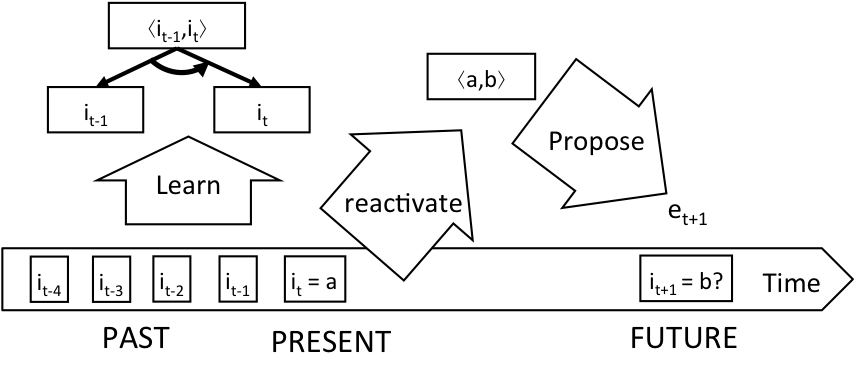
Lessons:
3. Constructivist epistemology

Home » 3. Constructivist epistemology » 32. Learning regularities
Figure 32 presents the principles of a rudimentary system that learns and exploits two-step regularities of interaction.

Figure 32: Rudimentary learning of regularities of interaction.
On time step t, the agent enacts the interaction it = ⟨et,rt⟩. Enacting it means experimenting et and receiving a result rt (Page 21). The agent records the two-step sequence ⟨it-1,it⟩ made by the previously enacted interaction it-1 and of it. The sequence of interactions ⟨it-1,it⟩ is called a composite interaction. it-1 is called ⟨it-1,it⟩'s pre-interaction, and it is called ⟨it-1,it⟩'s post-interaction. From now on, low-level interactions i = ⟨e,r⟩ will be called primitive interactions to differentiate them from composite interactions.
The enacted primitive interaction it activates previously learned composite interactions when it matches their pre-interaction. For example, if it = a and if the composite interaction ⟨a,b⟩ has been learned before time t, then the composite interaction ⟨a,b⟩ is activated, meaning it is recalled from memory. Activated composite interactions propose their post-interaction's experiment, in this case: b's experiment. If the sequence ⟨a,b⟩ corresponds to a regularity of interaction, then it is probable that the sequence ⟨a,b⟩ can be enacted again. Therefore, the agent can anticipate that performing b's experiment will likely produce b's result. The agent can thus base its choice of the next experiment on this anticipation.
Note that the enacted primitive interaction it may activate more than one composite interaction, each of them proposing different experiments. We create an interactionally motivated agent by implementing a decision mechanism that uses the agent's capacity of anticipation to choose experiments that will likely result in interactions that have a positive valence, and avoid experiments that will likely result in interactions that have a negative valence.
See public discussions about this page or start a new discussion by clicking on the Google+ Share button. Please type the #IDEALMOOC032 hashtag in your post: